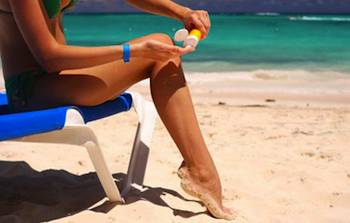- MENU
- HOME
- SEARCH
- WORLD
- MAIN
- AFRICA
- ASIA
- BALKANS
- EUROPE
- LATIN AMERICA
- MIDDLE EAST
- United Kingdom
- United States
- Argentina
- Australia
- Austria
- Benelux
- Brazil
- Canada
- China
- France
- Germany
- Greece
- Hungary
- India
- Indonesia
- Ireland
- Israel
- Italy
- Japan
- Korea
- Mexico
- New Zealand
- Pakistan
- Philippines
- Poland
- Russia
- South Africa
- Spain
- Taiwan
- Turkey
- USA
- BUSINESS
- WEALTH
- STOCKS
- TECH
- HEALTH
- LIFESTYLE
- ENTERTAINMENT
- SPORTS
- RSS
- iHaveNet.com: Health
Stacy Baker

My makeup bags and bathroom shelves are stocked with an arsenal of sun protection, ranging in SPF from 15 to 100 and in benefits from sweatproof to waterproof. I've been scared into believing that the higher the SPF on a product, the less I need to worry about sunburn, skin cancer or premature aging. Unfortunately, that isn't necessarily true.
The FDA has just released a new set of guidelines to help us better understand sunscreen labels. Now you can keep your skin safe, streamline your purchases and eliminate the time-suck of standing in front of the shelves trying to decipher countless sunscreen labels.
Here are the new rules and what you'll now find on shelves:
Find products labeled "broad spectrum."
These are sunscreens of an SPF 15 or higher that protect from both UVA rays (the kind that cause cancer) and UVB rays (those that cause sunburn). The FDA is requiring any product that isn't broad spectrum (and has an SPF value lower than 15) to note on its bottle that the formula helps reduce your risk of getting fried, but won't prevent against early aging or cancer. The FDA also wants to stop manufacturers from labeling sunscreens with values higher than SPF 50, since sufficient data to support those protection claims has yet to be found.
Dismiss benefits that are exaggerated.
You may love the idea of formulas that are waterproof, sweatproof or long-lasting, but the truth is they're not. The FDA deemed that these claims over-promise what the product can actually deliver. Under the new rules, manufacturers must remove these labels from their bottles. No matter how high the SPF value, no kind of protection lasts longer than two hours; products claiming otherwise must have data to back it up and get FDA approval.
Note the water-resistant designations.
While waterproof sunscreen doesn't necessarily stay put, water-resistant formulas can. Under the new guidelines, products that claim they remain effective while you sweat or swim need to state whether they work for 40 or 80 minutes, so you know when to reapply. Formulas that aren't water-resistant need to advise sunscreen users to choose a water-resistant product if they'll be in the heat or water. Your best bet: A water-resistant formula with SPF 15 or greater, which you can reapply every two hours.
Available at Amazon.com:
Copyright © All rights reserved.
AGING | ALTERNATIVE | AILMENTS | DRUGS | FITNESS | GENETICS | CHILDREN'S | MEN'S | WOMEN'S
Health - Protection Against Sunscreen Confusion